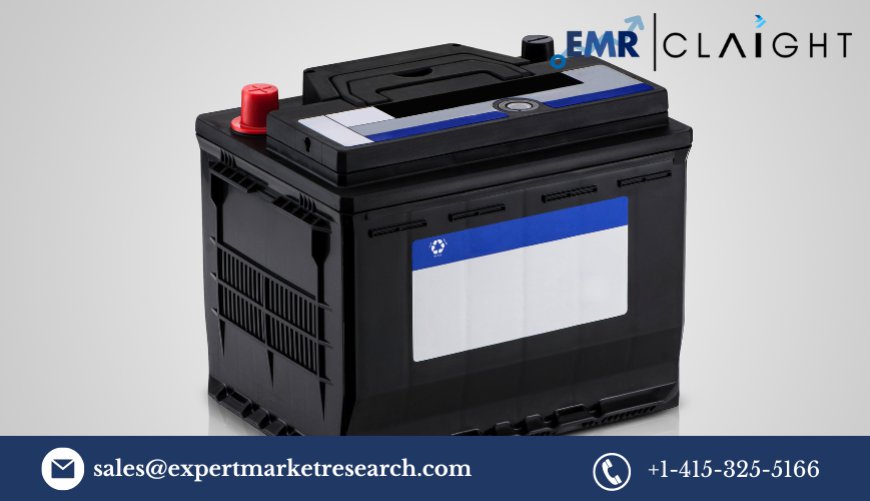SLI Battery Market: A Comprehensive Overview
SLI battery market is witnessing substantial growth due to the rising demand for vehicles globally. Forecasted to grow at a CAGR of 3% from 2024 to 2032.

The SLI battery market is witnessing substantial growth due to the rising demand for vehicles globally. Forecasted to grow at a CAGR of 3% from 2024 to 2032, the market's expansion is driven by various factors including technological advancements, increasing vehicle ownership, and improved recycling capabilities.
Understanding the SLI Battery
An SLI battery is a type of rechargeable battery primarily used in automotive applications. It consists of a lead-acid combination and is known for its high power output. Typically, an SLI battery has a lifespan of 3-6 years and comprises six cells arranged in an electrolytic fluid containing sulfuric acid, delivering a voltage output of 12V. These batteries are essential for starting engines, lighting, and ignition functions in vehicles.
Segmentation of the SLI Battery Market
The SLI battery market can be segmented based on type, sales channels, end-use, and regions:
By Type:
- Flooded
- Enhanced Flooded Battery (EFB)
- Valve-Regulated Lead-Acid (VRLA)
By Sales Channels:
- OEM (Original Equipment Manufacturer)
- Aftermarket
By End-Use:
- Automotive
- UPS (Uninterruptible Power Supply)
- Telecom
- Others
By Region:
- North America
- Europe
- Asia Pacific
- Latin America
- Middle East and Africa
Market Dynamics and Key Trends
Technological Advancements
The SLI battery market has seen significant improvements with the advent of new technologies such as start-stop systems and regenerative braking. These innovations enhance the efficiency and lifespan of SLI batteries, making them more attractive to consumers. Despite the environmental concerns associated with lead, the low cost and widespread availability of lead make SLI batteries a popular choice.
Recycling Capabilities
Enhanced recycling capabilities have played a crucial role in the growth of the SLI battery market. Efficient recycling processes reduce environmental impact and lower production costs, thereby driving market expansion.
Rising Demand for Personal Mobility
An increase in disposable incomes and the growing need for personal mobility have led to a surge in vehicle ownership, subsequently boosting the demand for SLI batteries. As consumers continue to use vehicles beyond their warranty periods, the need for battery replacements increases, further propelling market growth.
Regional Market Insights
Asia Pacific: Dominating the Market
Asia Pacific holds a significant share in the global SLI battery market, driven by high population densities in countries like China, India, and Indonesia. The region's large number of vehicles, coupled with a tendency to use vehicles beyond their warranty periods, results in frequent battery replacements. This trend is expected to continue, contributing to the region's dominant market position.
North America and Europe: Steady Growth
In North America, the market growth is comparatively slower but steady. The region's robust industrial infrastructure and high vehicle ownership rates support the demand for SLI batteries. Similarly, Europe, with its advanced automotive industry and stringent environmental regulations, is expected to witness steady growth in the SLI battery market.
Impact of COVID-19
The COVID-19 pandemic caused a temporary slump in the market due to disruptions in supply chains and decreased vehicle sales. However, as economies recover and industrial activities resume, the demand for SLI batteries is expected to rebound, particularly in the Asia Pacific region.
Key Players in the SLI Battery Market
The global SLI battery market is highly competitive, with several key players driving innovation and expansion. Notable companies include:
- Johnson Controls, Inc.
- East Penn Manufacturing Co., Inc.
- Leoch International Technology Limited Inc.
- GS Yuasa Corporation
- Crown Battery Manufacturing Company
- Exide Technologies
- Others
These companies are continuously investing in research and development to enhance their product offerings and maintain a competitive edge. Strategies such as mergers, acquisitions, and capacity expansions are common among these players to strengthen their market position.
SWOT Analysis of the SLI Battery Market
Strengths:
- High Demand: Continuous demand for vehicles ensures a steady market for SLI batteries.
- Technological Advancements: Innovations in battery technology enhance performance and lifespan.
- Recycling Capabilities: Improved recycling processes reduce environmental impact and production costs.
Weaknesses:
- Environmental Concerns: Lead, a primary component in SLI batteries, is a significant pollutant.
- Limited Lifespan: SLI batteries have a relatively short lifespan compared to newer battery technologies.
Opportunities:
- Emerging Markets: Growing automotive industries in developing countries present significant growth opportunities.
- Technological Integration: Adoption of advanced technologies like start-stop systems can drive demand.
Threats:
- Environmental Regulations: Stricter environmental regulations may impact production processes and increase costs.
- Competition: The rise of alternative battery technologies, such as lithium-ion batteries, poses a threat to the SLI battery market.
Porter’s Five Forces Analysis
1. Bargaining Power of Suppliers:
Moderate. While there are numerous suppliers of raw materials like lead, the dependency on specific suppliers for quality and price stability gives them moderate power.
2. Bargaining Power of Buyers:
High. With many alternatives available, buyers have significant power to demand better prices and higher quality.
3. Threat of New Entrants:
Moderate. High initial investment and stringent regulations pose barriers to new entrants, but technological advancements could lower these barriers over time.
4. Threat of Substitutes:
High. The growing popularity of alternative energy storage solutions, such as lithium-ion batteries, poses a significant threat.
5. Industry Rivalry:
High. The presence of established players and continuous technological advancements intensifies competition.
The SLI battery market is poised for steady growth, driven by increasing vehicle demand, technological advancements, and improved recycling capabilities. Asia Pacific, with its large population and growing automotive industry, is expected to remain a dominant player in the market. Despite challenges such as environmental concerns and competition from alternative technologies, the SLI battery market offers significant growth opportunities for companies that continue to innovate and adapt to changing market dynamics.

 JMillence
JMillence